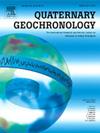Novel age constraints on offshore islets around Taiwan with implications for the northern Taiwan volcanic zone
IF 2.5
2区 地球科学
Q3 GEOGRAPHY, PHYSICAL
引用次数: 0
Abstract
Determining the exact age of volcanic activity in the Northern Taiwan Volcanic Zone (NTVZ) is essential for comprehending Taiwan's tectonic evolution. The timing and duration of the volcanic processes that formed the NTVZ remain uncertain despite the availability of geochronological, geochemical, and geophysical data. While extensive efforts have been directed towards investigating the age of the Tatun Volcanic Group, the primary feature of the NTVZ, many other aspects require further examination. This study concentrates on two offshore islets in the northern region of the NTVZ. We present new 40Ar/39Ar ages of 0.252 ± 0.018 Ma for a lava flow, representing an early stage of volcanic activity, and 0.118 ± 0.012 Ma for a dike, representing the latest stage of volcanic activity around Pengjia Islet. A sample collected from Mianhua Islet did not yield a reasonable age due to high uncertainty, likely attributable to young and low radiogenic argon. Field observations support the interpretation that volcanic activity on both islets is considerably younger than previously estimated. This study corroborates the hypothesis from geophysical studies that submarine NTVZ features to record a potentially active magmatic reservoir offshore of northern Taiwan. By refining our understanding of spatio-temporal patterns in volcanic activity, this study contributes to volcanic hazard assessment in Taiwan and surrounding areas.
台湾周边近海小岛的新年龄限制因素及其对台湾北部火山带的影响
确定北台湾火山带(NTVZ)火山活动的确切年代对于理解台湾的构造演化至关重要。尽管有地质年代、地球化学和地球物理数据,但形成北台湾火山带的火山过程的时间和持续时间仍不确定。虽然人们已经为研究大屯火山群(NTVZ 的主要特征)的年龄做出了大量努力,但还有许多其他方面需要进一步研究。本研究集中于北部岩溶带北部地区的两个近海小岛。我们为彭家垴附近的一个熔岩流(代表火山活动的早期阶段)和一个堤坝(代表火山活动的晚期阶段)提供了新的 40Ar/39Ar 年龄,分别为 0.252 ± 0.018 Ma 和 0.118 ± 0.012 Ma。从棉花屿采集的样本由于不确定性较高,没有得到合理的年龄,这可能是由于年轻和低放射性氩造成的。实地观察支持这样的解释,即这两个小岛上的火山活动比以前估计的要年轻得多。这项研究证实了地球物理研究的假设,即海底 NTVZ 特征记录了台湾北部近海潜在的活跃岩浆库。通过完善我们对火山活动时空模式的理解,本研究有助于台湾及周边地区的火山灾害评估。
本文章由计算机程序翻译,如有差异,请以英文原文为准。
求助全文
约1分钟内获得全文
求助全文
来源期刊

Quaternary Geochronology
地学-地球化学与地球物理
CiteScore
4.40
自引率
22.20%
发文量
130
审稿时长
20 weeks
期刊介绍:
Quaternary Geochronology is an international journal devoted to the publication of the highest-quality, peer-reviewed articles on all aspects of dating methods applicable to the Quaternary Period - the last 2.6 million years of Earth history. Reliable ages are fundamental to place changes in climates, landscapes, flora and fauna - including the evolution and ecological impact of humans - in their correct temporal sequence, and to understand the tempo and mode of geological and biological processes.
 求助内容:
求助内容: 应助结果提醒方式:
应助结果提醒方式:


